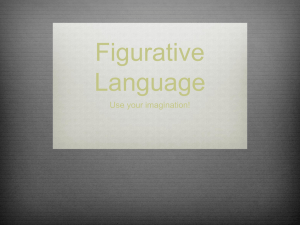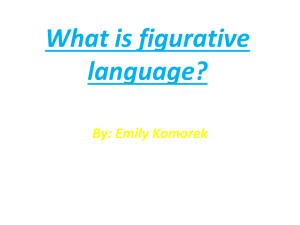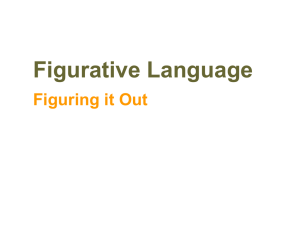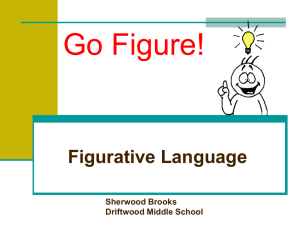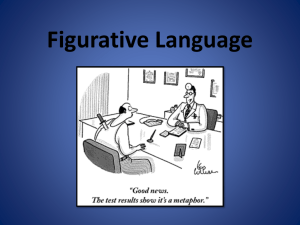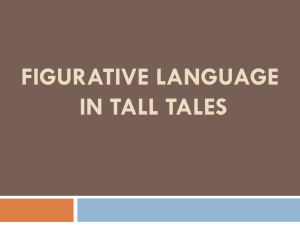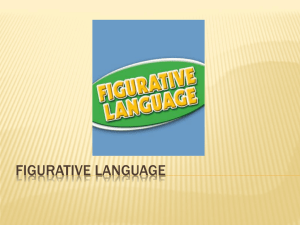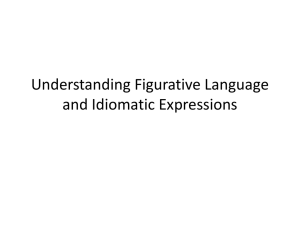What is Figurative Language? - mkmoore
advertisement
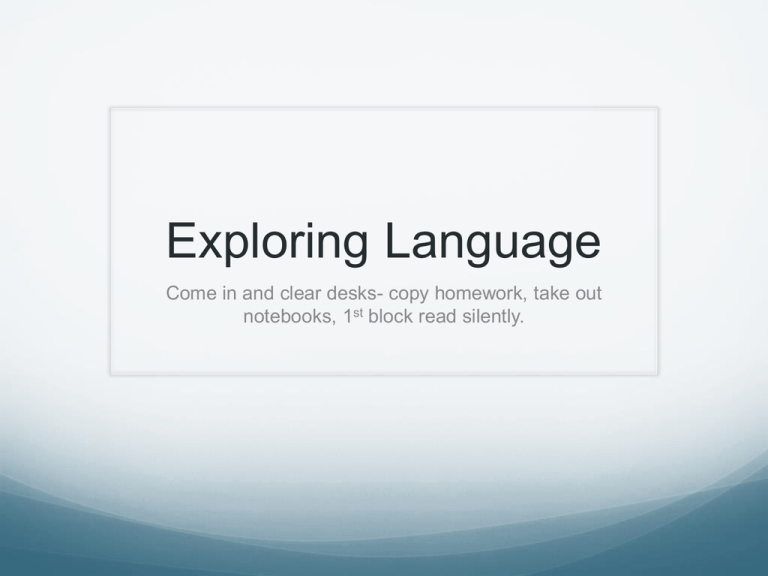
Exploring Language Come in and clear desks- copy homework, take out notebooks, 1st block read silently. Warm Up: Language Vocabulary- Use the glossary to find the definitions. Sensory Language/ Imagery: Onomatopoeia: Alliteration: Personification: Rhythm: Simile Metaphor: Hyperbole: Imagery: Fill in the blanks with information about figurative and sensory language. Figurative Language Figurative Language is when an What is Figurative Language? author makes their writing more interesting by adding comparisons or expressions to convey their feelings Figurative Language Simile: when you compare two somewhat unlike things using “like” or “as” Ex: Busy as a bee What are types of figurative language? Metaphor: a comparison of two seemingly unlike things, which does not include “like” or “as” Ex: You are what you eat Personification: A figure of speech in which human characteristics are given to an object or an animal Ex: My computer hates me Figurative Language Alliteration: The repetition of the same sound in a series of words. Ex: Charlie chases cheetahs Onomatopoeia: The use of a word to imitate or synthesize a natural sound or the sound made by an object or an action Ex: Snap! Crackle! Pop! Hyperbole: An exaggeration that is so big that no one would believe the statement is true Ex: This class is taking forever! Idiom: An idiom is a funny expression in Practice With a partner, choose a theme from below and write as many examples of figurative language as you can think of. Themes to Choose From: Summer Holidays School Food Sports People Animals nature Example: Home • The dog snores like a chainsaw.- Simile • The kitchen is the heart of the home.- Metaphor • My computer seems to hate me today.- Personification • Leigh likes lemonade and lollipops- Alliteration • Woosh! There is something wrong with the washer. Onomatopoeia Homework: Write an original example of each type of figurative language: Simile Metaphor Personification Hyperbole Warm Up Identify the figurative language in each. 1. The sorry engine wheezed its death cough. 2. My dad is always working. That was the easiest question in the world. 3. The typical teenage boy’s room is a disaster area. 4. Food?” Chris inquired, popping out of his seat like a toaster strudel. 5. That was the easiest question in the world. Recognizing Figurative Language The opposite of literal language is figurative language. Figurative language is language that means more than what it says on the surface. It usually gives us a feeling about its subject. Poets use figurative language almost as frequently as literal language. When you read poetry, you must be conscious of the difference. Otherwise, a poem may make no sense at all. Recognizing Literal Language “I’ve eaten so much I feel as if I could literally burst!” In this case, the person is NOT using the word literally in its true meaning. Literal means "exact" or "not exaggerated." By pretending that the statement is not exaggerated, the person stresses how much he has eaten. Literal language is language that means exactly what is said. Most of the time, we use literal language. What is figurative language? Whenever you describe something by comparing it with something else, you are using figurative language. Types of Figurative Language Simile Metaphor Alliteration Personification Onomatopoeia Hyperbole Idioms Simile A figure of speech which involves a direct comparison between two unlike things, usually with the words like or as. Example: The muscles on his brawny arms are strong as iron bands. Metaphor A figure of speech which involves an implied comparison between two relatively unlike things using a form of be. The comparison is not announced by like or as. Example: The road was a ribbon wrapped through the dessert. Alliteration Repeated consonant sounds occurring at the beginning of words or within words. Example: She was wide-eyed and wondering while she waited for Walter to waken. Personification A figure of speech which gives the qualities of a person to an animal, an object, or an idea. Example: “The wind yells while I walk in the woods." The wind cannot yell. Only a living thing can yell. Onomatopoeia The use of words that mimic sounds. Example: The firecracker made a loud ka-boom! Hyperbole An exaggerated statement used to heighten effect. It is not used to mislead the reader, but to emphasize a point. Example: She’s said so on several million occasions. Idioms An idiom or idiomatic expression refers to a construction or expression in one language that cannot be matched or directly translated wordfor-word in another language. Example: "She has a bee in her bonnet," meaning "she is obsessed," cannot be literally translated into another language word for word. Literal Vs. Figurative Literal vs. Figurative You will get an example of Figurative language. Analyze it for both literal and figurative meanings. Then draw a picture that illustrates the FIGURATIVE meaning. Figurative Language Examples For Illustrations: Ellie’s cell phone dropped into the toilet like a falling star. “Food?” Chris inquired, popping out of his seat like a toaster strudel. Grandpa lounged on the raft in the middle of the pool like an old battleship. If seen from above the factory, the workers would have looked like clock parts. Toby manipulated the people in his life as though they were chess pieces. Kathy arrived at the grocery store with an army of children. Waves of spam emails inundated his inbox. Her eyes were fireflies. Nothing can bother him. I can smell pizza from a mile a way. I went home and made the biggest sandwich of all time. The cactus saluted any visitor brave enough to travel the scorched land. The world does not care to hear your sad stories. Warm Up Choose two vocabulary words from our list and create two word squares. Definition: Sentence: Example: Illustration Review and Discuss What is figurative language? Why do you think author’s use it? What are the types? How are the types used? How does figurative language improve reading? Gallery Crawl Travel around the room and find the Figurative Language examples on the wall. On the chart write the type of figurative language and the meaning. The wallpaper jumped off the wall. 2. What type of Figurative language? What does it mean? The wallpaper jumped off the wall. 3. What type of Figurative language? What does it mean? In the morning the city spread its wings. What type of Figurative language? What does it mean? The fog comes on like little cat feet. 4. What type of Figurative language? What does it mean? Her teeth are pearls. 5. What type of Figurative language? What does it mean? She’s so tired she could sleep for ten years. 6. What type of Figurative language? What does it mean? The sun kissed the dew off the grass.. 7. What type of Figurative language? What does it mean? Her eyes are like blue marbles. 8. What type of Figurative language? What does it mean? The sweet smell of pumpkin pie filled the air. 9. What type of Figurative language? What does it mean? The witch’s eyes looked like two brown swamps. 10. What type of Figurative language? What does it mean? His desk is a jungle. Homework Read for 30 minutes and write a summary of what you have read. Warm Up: Use simile, metaphor, personification, or hyperbole to describe three of the objects below. http://www.youtube.com/watc h?v=xe4_3EAaLJ8 Watch the short video and complete 3-2-1 3-new facts about similes and metaphors 2-unanswered questions about similes and metaphors 1- overall summary of the video Independently Complete the simile and metaphor sheet. Read carefully- Take your time- quiz grade Trade and Grade Trade papers 3 times Use a marker Only mark the one that are incorrect Ticket Out I learned… I liked… I struggled with… I still have questions about… Warm Up Write a quick poem describing a friend using only similes and metaphors. Example: Her hair is like silvery straw And her laugh is a whistle She is as wise as an owl Her eyes are like the ocean She knows me like the back of her hand Review from Guided Notes Personification: Definition: Explain in your own words: Examples: Hyperbole: Definition: Explain in your own words: Examples: Personification What does each sentence mean? What is the personification? The ancient car groaned into third gear. The cloud scattered rain throughout the city. The tropical storm slept for two days." Personification Challenge Complete the activities with a partner to practice personification. Remember you are giving a non-human object human characteristics. Homework Vocabulary Square- Quiz tomorrow Hyperbole: Definition Sentence Example Picture


